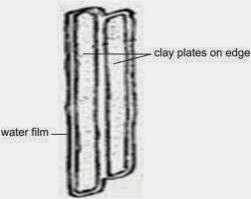Secondary clay or sediment (sludge) is a type of clay that is the result of weathering of rocks feldspatik move away from its parent rock due to exogenous force that causes the clay granules off and settles in low-lying areas such as river valleys, wetlands, marine land, the land of lakes .
In the course because of the water and angina, clay mixed with organic materials and inorganic thus changing the nature of the chemical and physical properties of clay into particles that produce secondary clay finer and more plastic. The number of secondary clay over more than primary clay. Water transport has a specific effect on clay, one of which is the movement of water currents tend to erode the clay mineral particles become progressively smaller and smaller.
At the current pace slows, heavier particles will settle and leave the fine particles in the solution. At the current time of calm, like a lake or at sea, the fine particles will settle to the bottom. Bisaanya moved clay formed from different types of clay and come from several sources.
In each river, clay sediments from several sites tend to be mixed together. The presence of various metal oxides such as iron, nickel, titan, manganese and so on, from the point of ceramic science considered as impurities. Organic matter such as humus and leaf rot is also a clay impurities.
Since the formation through a long process and mixed with impurities, the clay has the properties: fine-grained, beige / gray / brown / pink / yellow, ripe temperatures between 9000C-14000C. In general, secondary clay more plastic and has a power greater shrinkage than primary clays.
The higher the temperature the harder grilled and the smaller the porosity, so that objects become water-resistant ceramics. Compared with clay primary, secondary clay is characterized not pure, the color is darker, finer grained and has a melting point that is relatively lower. Once burned secondary clay usually beige, light gray to light brown to dark.
Secondary lit land has characteristics:
Tend to be less pure fine grained, plastic, beige / gray / brown / pink / yellow, yellow, yellow brown, reddish, black high power losses, temperature 12000C-13000C fuel, there are up to 14000C (fireclay, stoneware, ballclay), low fuel temperature 9000C-11800C, there are up to 12000C (Earthenware).
Ground color of the soil occurs naturally because of the element iron oxides and organic elements, which would normally burn tawny colored, brown, red, rust color, or dark brown, depending on quantity and iron oxides and impurities contained. Usually the iron oxide content of about 2% -5%, in the presence of these elements tend to land Iebih dark colored, usually cooked at lower temperatures, the opposite is the lighter colored soil or white will mature at higher temperatures.
According to its melting point, secondary clay can be divided into five major groups, namely: refractory clay (fire clay), stoneware clay, ball clay, red clay (Earthenware clay), and clay types monmorilinit.
